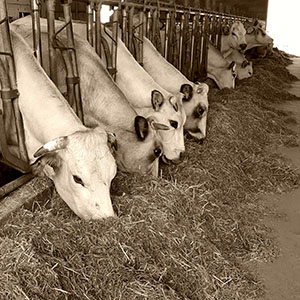Evaluation of the environmental impacts of suckler calf-to-beef mixed crop-livestock farms in northern Italy: A farm-based study

Accepted: 31 May 2022
Appendix: 65
HTML: 41
All claims expressed in this article are solely those of the authors and do not necessarily represent those of their affiliated organizations, or those of the publisher, the editors and the reviewers. Any product that may be evaluated in this article or claim that may be made by its manufacturer is not guaranteed or endorsed by the publisher.
The issue of the environmental impacts of beef production has been extensively debated in recent years. However, the research on this theme has mainly been based on farm-model studies with limited attention to contribution analysis of impact categories and aspects linked to cropping systems and feed self-sufficiency in mixed crop-livestock farms. This study evaluated the cradle-tofarm gate environmental impacts of mixed-crop livestock farms rearing the Piedmontese beef breed and suckler calf-to-beef operations in Northwest Italy. Data have been collected from detailed on-farm questionnaires, field books, and invoices of 11 farms over two years (2017-2018). The environmental impacts have been evaluated in terms of land occupation (LO, m2/year), global warming potential (GWP, kg CO2-eq), acidification potential (AP, g SO2-eq) and non-renewable cumulative energy demand (CED, MJ), using life cycle assessment methodology. The functional unit considered was one kilogram of live weight produced at the farm gate. The Piedmontese beef production system showed comparable average environmental impacts with those found in other studies, even though high variability was observed in the studied farms. The GWP averaged 15.7 kg of CO2 eq/kg LW and ranged from 12.1 to 17.6 kg of CO2 eq/kg LW. The CED, LO and AP were on average 62.4 MJ/kg LW, 18.5 m2/y/kg LW and 305 g SO2 eq/kg LW, respectively. Differences in environmental impacts and GWP contribution analysis were mainly due to differences in cropping system management strategies and the consequent levels of feed self-sufficiency. A positive effect of high fertility and animal productivity was observed on the GWP (r=0.62; P<0.01), highlighting the importance of improving efficiency of these aspects for the reduction of emissions. From the contribution analysis of impact categories, the high cost of purchased feeds (in particular protein feeds), transport, and mineral fertilizers for feed production were highly relevant. However further research is needed to confirm these findings.
Highlights
- Study of 11 farms for two years.
- High relevance of purchased feeds on environmental impacts.
- Productive and reproductive performances are key points in reducing environmental impacts.
- Importance of the valorisation of farm crop surfaces to satisfy animals’ needs.
How to Cite

This work is licensed under a Creative Commons Attribution-NonCommercial 4.0 International License.
PAGEPress has chosen to apply the Creative Commons Attribution NonCommercial 4.0 International License (CC BY-NC 4.0) to all manuscripts to be published.

 https://doi.org/10.4081/ija.2022.2017
https://doi.org/10.4081/ija.2022.2017



